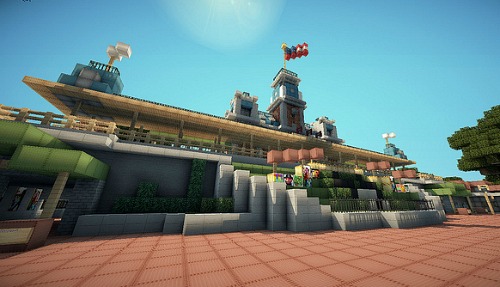
A view within Minecraft
Searching for some great ways to get kids hooked on creating digital content? Then be sure to check out Minecraft, the critically acclaimed, mega-selling video game that’s attracted legions of devoted teen and tween fans, says Erin Daly, a participant in School Library Journal and Library Journal’s “The Digital Shift: Libraries, Ebooks, and Beyond,” an October 17 online event that explored how to make the leap from print to digital tools in the classroom.
Daly ought to know. She runs two popular Minecraft groups—one for teens, the other for kids ages 9 to 12—at the Chicopee Public Library in Massachusetts, where she’s a teen librarian. Daly’s young patrons not only use the opened-ended adventure game to create animals, monsters, and potions, but lately, they’ve even gotten into dressing like some of the game’s characters, which include an energetic array of zombies, skeletons, and oversized spiders.
What’s her number-one piece of advice to librarians and other educators who’d like to make the crowd-pleasing video game part of their instructional repertoire but may be afraid to get their feet wet? “Just play it,” says Daly, one of three panelists in a one-hour session called “Make Your Own: Maker Culture in the Library,” which was moderated by Melissa Techman, a K–5 librarian at Broadus Wood Elementary School in Earlysville, VA.

Left to right: Liz Castro, Erin Daly, Wesley Fryer, Melissa Techman
Wesley Fryer, another panelist, shares Daly’s devotion to all things digital. “My personal passion now is to really help students to create media products and become better multimedia users,” says Fryer, a digital learning consultant and the author of Playing with Media: Simple Ideas for Powerful Sharing (Speed of Creativity Learning, 2011). To get kids going, he’s created a project called “Mapping Media to Common Core,” which features “12 different products that students can create,” including their own ebooks, he says. (Fryer’s slide deck embedded below)
“One of the things that Common Core requires kids to do is to be digitally publishing their work,” explains Fryer. That’s why during the last six months, Fryer has helped elementary and middle school kids at Oklahoma’s Yukon Public Schools build their own ebooks with text, images, audio, and hyperlinks. It was while working with second graders that Fryers says he experienced a tech-based epiphany: “touch tablets and great apps”—like Book Creator—“can really empower students to do things they wouldn’t have been able to do independently,” he says.
Liz Castro, a fellow panelist, doesn’t need to be convinced about the power of ebooks. When she saw her first iPad in April 2010, she immediately realized that “people would want to create ebooks” for the tablet device. As Castro delved deeper into electronic books, she says she also realized that by using EPUB, “anyone can create an ebook, and that’s an amazing thing—especially for all of those kids and all of those people in libraries and schools who want to create their own content.”
Plus, says Castro, the tools for creating ebooks, such as a text editor, aren’t complicated and aren’t expensive, and there’s no need for teachers and librarians to feel intimated by them.
Castro adds that there’s no need to feel overwhelmed by today’s ebooks’ divergent formats: EPUB and Kindle, which are both based on HTML, a markup language that’s used to create Web pages and other digital content.
That’s good news for those educators who aren’t completely fluent in HTML—or for that matter, in CSS, Perl/CGI, XML, and other scripting languages, which Castro, who began writing computer books about 20 years ago, is able to zip through in her sleep. “Really the barriers to publishing your own ebooks are incredibly low,” she says, noting that it’s necessary to purchase an ISBN number for each title. “And that’s the part that makes me the happiest.”


